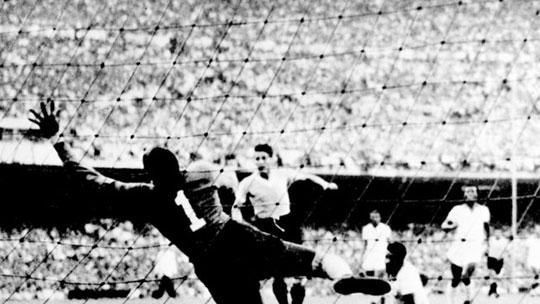From violent peasants to multi-million pound megastars: the history of football
Primary page content
If you love football, you're probably only aware of its history from recent times. But football has a long, gruesomely violent, and hugely interesting past. And so begins a tale of how a violent peasant pastime became a multi-million pound industry.

In the ninth century in Britain, a monk recorded how every year on Shrove Tuesday the youth of London "would go into the fields to play at the famous game of ball".
Unlike expensive courtly pursuits such as jousting, these games required no specialised equipment and were thus open to all social classes. The innovation of a goal (usually a prominent local landmark) may have derived from the chivalric "passage of arms", a military exercise in which a group of knights attempted to defend the gate of a castle or town from attack.
Mob football
The first unambiguous reference to football in England is a writ for preserving the peace in London (dated 13 April 1314), which notes the "great uproar in the City, through certain tumults arising from the striking of large footballs in the public fields". That football could lead to serious injury or death is borne out by the records. In 1321, for example, one player died from wound sustained after accidentally running onto a sheathed knife.
Yet despite a succession of royal proclamations promoting archery and a statute of 1409-10 forbidding labourers and servants from "playing at the Balls", this "common, undignified, and worthless" game remained ever popular.
Football was also entertaining; a spectator sport in the making. The dangers of the game though, remained. Civic authorities in 17th-century London, Manchester, Grimsby and Clitheroe banned football playing in the streets, fearing broken windows and tumults.
They were not being alarmist, as a riot instigated by football players in the fens only a few months before the outbreak of the First English Civil War demonstrated. Another disturbance became a prelude to the Second Civil War: unhappy that Christmas had been abolished, rioters at Canterbury used a football match to attract an unruly crowd to their cause.
In the 18th century, the rules we now recognise on the pitch today, began to emerge. At one match it was determined that "two men will not be allowed to engage one only". Similarly, at a game played at Ditchingham in 1741, there were judges whose job was to settle "all differences that may arise."
By the late 18th century, members of the aristocracy, keen to have a healthy work force, began organising matches - often in concert with local publicans. Prizes in the form of hats were provided for the winners (losers tended to receive stockings).
Public school rules
From the late 18th century and through into the 19th century, increased concern for public order, tighter labour discipline, the enclosure of land and migration to the cities led to an erosion of popular customs. Football was not immune from these changes.
Though the game continued to be played in highly publicised contests, traditional football was in decline. At the same time the public schools, where hitherto football had been regarded as ungentlemanly and "fit only for butcher boys", began to codify the rules of their ball games.
At Rugby, written rules that permitted players to carry ball were set down in 1845. Eton followed suit in 1849 with rules that, in deliberate contrast to Rugby, forbade Etonians from handling the ball. At the universities, undergraduates brought with them the rules favoured by their public schools.
After some attempts to reconcile the various codes Cambridge produced a revised code in 1863 which made no mention of handling the ball. These Cambridge rules were to form the basis of the code eventually adopted by the Football Association established later that year.

Students playing football on the back field
Passion and professionalism
The growth of Association Football in the late 19th century was remarkable. Amateur clubs sometimes linked to firms or churches, but more often reflecting neighbourhood loyalties, mushroomed in the industrial towns and cities of the north (in the 1880s Liverpool alone had more than one hundred).
Many teams built their grounds among factories and the worker's houses, cementing the support of their local communities. By the early 20th century many of the largest cities had two major teams and the often intense local rivalry between these clubs was regularly played out before hordes of excited, partisan spectators that represented the largest regular gatherings in peace-time.
The sectarian-fuelled passions of the 50,000 or more who regularly witnessed the New Year's Day clashes between Celtic and Rangers found an outlet in 1909 when 6,000 fans rioted following a draw between the two teams; 54 policemen were injured, the ground damaged and virtually every street-lamp in the vicinity of the stadium destroyed.
The fierce competitiveness that drove teams towards league and cup glory accelerated the professionalisation of football. Hungry for success on the pitch, teams began to recruit players from far and wide to realise their ambitions. Victorious teams, like the side that won the cup for Tottenham Hotspur in 1901, often contained no local players. Yet supporters continued to identify with the individuals that wore their team colours.
Professional football players were perceived as working-class heroes and were paid accordingly: in 1931 the maximum annual salary of a professional footballer (including unofficial bonuses) was probably nearly £400, a figure far higher than the average industrial wage. Transfer fees were also forever on the increase.
In the 1930s football was still seen as cheap entertainment, but it was also big business, providing growing employment opportunities. Demand for news had created sports papers like the Saturday afternoon Pink 'Un and Green 'Un. Demand for food and drink benefited the catering trade. Demand for cigarettes led to the cult of the cigarette card made famous by John Player and Son. And the demand for gambling spawned pools companies like Littlewoods and Vernons.
There was also advertising; the FA Cup finalists of 1934 promoted flannel trousers, Shredded Wheat and shoe-polish. By the eve of the World War II, The Times could describe football as "something like a national industry".
The golden age?
In the post-war era we have witnessed an ever-widening gulf between rich and poor clubs, where success for the elite is no longer measured by performance on the pitch but by performance on the stock exchange.
Clubs now recruit managers from outside the UK and buy players of every nationality. In their wake have come team doctors, dieticians, sports psychologists and publicists. Players are now celebrities with agents and personal assistants. The best earn more in a week than the prime minister does in a year – and more in six weeks than a nurse will make in a lifetime of service with the NHS.
The spectacle we watch and read about daily is sold to us with an ever-increasing sophistication that maximises a brand loyalty unparallelled on the high street.
Football has never had it so good, but questions remain as to the game's future direction. Will, as some predict, the industry bubble burst? Will fans tire of a handful of clubs cleaning up domestically and sharing the European prizes between them? Financial Fair Play has proved to be toothless. Hardly a surprise, perhaps, given the high-stakes nature of the game.
So what now? No salary caps and unlimited transfer fees mean that in England there's nothing to prevent the richest clubs from buying not only the best established players but also many unproven kids – stars in the making who aren't yet old enough to vote. And if the best indicator of where a team will finish is its annual wage bill – occasional managerial brilliance and incompetence excepted – things might get a little too predictable for fans already forced to shell out more to watch a game than they ever have before.